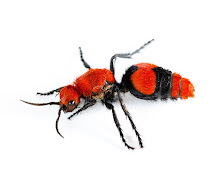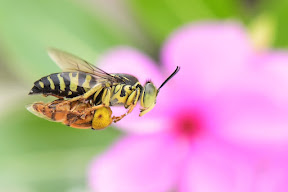If it seems to you that lately every time you go outside there are more and more wasps around, then you are correct. In the latter part of summer and early fall, wasp populations are at their largest and all those wasps are out and about busily bulking up their queens and colonies. Wasps get a bad rap; they are amazing creatures that are crucial for a healthy ecosystem and not aggressive, people-hating bad guys. The more you know about them, the easier they are to like.
Types of Wasps
There are two main types of wasps: solitary and social. The solitary wasp species are the vast majority of 75,000 or so wasp species out there. Solitary wasps are mostly predatory and parasitic (we sell some as
aphid predators). While their habits may be horrific to their arthropod and insect prey, they couldn’t care less about people. As their names suggest, solitary wasps live on their own and social wasps live in colonies. Wasp colonies are usually a great deal smaller than bee colonies. They will typically have only a dozen or so individuals, although some species can have hives with up to 10,000 inhabitants. Bees, on the other hand, routinely have colonies of 50,000 or more. So, mathematically speaking, you have a greater chance of coming into conflict with bees than wasp. For more information, check out
this article.
To Sting or Not to Sting
 |
| Velvet Ant |
The fear of getting stung is what seems to drive the irrational hatred for wasps. But, unless you have an allergy (which can be very serious), the pain of the sting should not be overwhelming for most adults. The exception would be certain solitary wasps, like the wingless Velvet Ant wasp, that may sting if provoked and can be VERY painful. Any wasp will sting if it feels threatened, but the majority of stings occur when people get too close to or disrupt the activity of the hive Since solitary wasps do not live in hives, they have no reason to sting to protect one. On the other hand, like most animals, social wasps will aggressively defend their homes and offspring. They will fearlessly dive-bomb and sting intruders. So, just as you would do with a mama bear, back away and leave them alone.
Wasp Nests
Wasp nests, and their proximity to humans, seems to be the flashpoint for confrontation between wasps and people. But the solution is not necessarily to seek out and destroy the hives. In most cases, it is probably better to leave them where they are. First, try to determine if there is in fact a hive nearby (not all are easily visible) – observe their comings and goings to see if they regularly fly to the same sheltered areas (unused equipment like barbecues, sheds, under the eaves) or crevices (cracks in foundations, wall cavities). Once you know where they are, you can plan where not to be. Bear in mind that wasps don’t swarm and that
most nests will be abandoned once summer is over. If you are still uncomfortable with the nest being nearby, have it removed by a professional. While wasps don’t swarm, if you try to get at a nest you will be stung many times by many individuals. From more information on how to avoid confrontations with wasps, read
this article.
Biodiversity
 |
| Sand Wasp with prey |
The presence of a thriving wasp population helps keep the biodiversity therein robust. Wasps are at the top of the inveterate food chain and, as generalist predators, wasps will prey on all manner of spiders, millipedes, caterpillars and soft-bodied insects. Whether through parasitization or direct consumption, they keep pest populations of insects and arthropods in check. In this way they protect lower invertebrates and plants from indiscriminate predation that could cause an imbalance in the system which could lead to many serious consequences, including crop failure.
Wasps as Pollinators
Those chubby little honeybees get all the pollinator love, but wasps do their part as well. While they do not gather pollen to take to their hive and turn into honey, they become covered in pollen as they search all parts of flowers and plants for prey. As they move on in their hunt, they take the pollen with them and spread it around. And then there are the specialist wasps like the
Fig Wasps. These insects have developed a symbiotic relationship with the plants they visit. In tropical ecosystems, the fig is an essential food source for a great many species, and without this particular wasp that would be gone.
 |
| Fig Wasp |
Wasps Could Cure Cancer
Could it be that a lowly wasp is the key to wiping out the curse of cancer? Scientists are learning that a certain Brazilian wasp has venom that destroys cancer cells. It’s still early days on a possible cure, but this illustrates just how important wasps can be.
I hope that this has changed some thinking about the importance of wasps in the ecosystem. If you still want to control them around you, our
Yellow Jackets, Hornets and Wasps page has more information and a variety of non-poisonous controls.
Take Care
Submitted by Pam













No comments:
Post a Comment